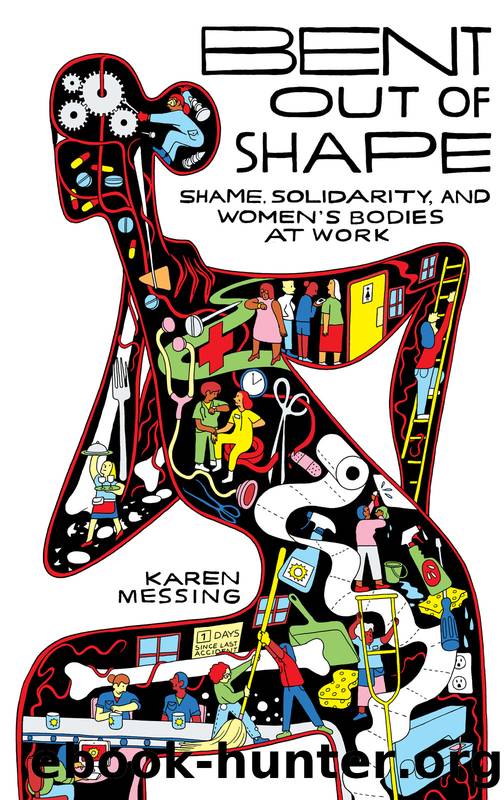Bent out of Shape by Karen Messing

Author:Karen Messing
Language: eng
Format: epub
Publisher: Between the Lines
Observing the work and asking questions
Observation is the key tool of ergonomists, and it is here that ergonomic studies distinguish themselves from those based on interviews. In fact, classic texts in francophone ergonomics employ the expressions âreal workâ (travail réel) as observed, to be contrasted with âassigned tasksâ (travail préscrit).3 The observations are oriented to produce a âtrueâ and complete picture of the ârealâ work process, its determinants, requirements, and constraints.4 The interviews we do complement and explain the observations.
The first observations help us figure out the work process. Usually this stage involves fifty to a hundred hours or so. We observe a variety of people, job titles, situations, and shifts. During this stage, we saw that sometimes a counsellor worked in physically constrained postures that seemed unhealthy and, at first, unnecessary. But the counsellor told us she had to position herself so that she could always see out of the front window of the shelter, because a dangerous ex-partner might show up. She showed us all the precautions she took to avoid being seen from the street, while seeing everything around her. We were introduced to all the complicated procedures surrounding the use of telephones and doors. What if a resident called her aggressor and, in a moment of tender reconciliation, revealed the location of the shelter? Or what if she opened the door to a violent not-so-ex-partner, putting everyone at risk? Observing made us aware of how much the possibility of violence conditioned counsellorsâ tiniest gestures.
We also learned about the practical implications of feminist principles. For example, all interactions with residents are considered to be potentially empowering, part of the healing process. Therefore there is no particular priority given to formal interviews with residents, as opposed to cooking a meal with them. Both are opportunities for support and empowerment. Although counsellors tried hard to spend formal time with residents, those interviews could be interrupted, and very often were.
We also learned about the sociopolitical context. We heard about a chronic lack of funds, leading to understaffing, low pay, and consequent rapid staff turnover. Some counsellors said they had trouble defending their work to skeptical friends and family. Those in a semi-rural setting felt exposed, since they were visible to their community and sometimes targeted as man-haters. Many said they never told people they met exactly what they did for a living.
We saw direct consequences of understaffing. Two counsellors scheduled a meeting to deal with a problem among residents. It was timed so that a volunteer could take care of the residentsâ children during the meeting. But one counsellor was on the telephone when the babysitter arrived and the other counsellor had to start the meeting alone. Then the other telephone rang and the second counsellor had to leave the meeting to answer it because any call could be a cry for help from a woman facing imminent violence.
When we asked why someone wasnât specifically hired to answer the phone, we heard different answers. Some had to do with funding,
Download
This site does not store any files on its server. We only index and link to content provided by other sites. Please contact the content providers to delete copyright contents if any and email us, we'll remove relevant links or contents immediately.
Whiskies Galore by Ian Buxton(41935)
Introduction to Aircraft Design (Cambridge Aerospace Series) by John P. Fielding(33085)
Small Unmanned Fixed-wing Aircraft Design by Andrew J. Keane Andras Sobester James P. Scanlan & András Sóbester & James P. Scanlan(32763)
Craft Beer for the Homebrewer by Michael Agnew(18194)
Turbulence by E. J. Noyes(7977)
The Complete Stick Figure Physics Tutorials by Allen Sarah(7334)
Kaplan MCAT General Chemistry Review by Kaplan(6897)
The Thirst by Nesbo Jo(6877)
Bad Blood by John Carreyrou(6581)
Modelling of Convective Heat and Mass Transfer in Rotating Flows by Igor V. Shevchuk(6406)
Learning SQL by Alan Beaulieu(6236)
Weapons of Math Destruction by Cathy O'Neil(6207)
Man-made Catastrophes and Risk Information Concealment by Dmitry Chernov & Didier Sornette(5951)
Digital Minimalism by Cal Newport;(5700)
Life 3.0: Being Human in the Age of Artificial Intelligence by Tegmark Max(5507)
iGen by Jean M. Twenge(5384)
Secrets of Antigravity Propulsion: Tesla, UFOs, and Classified Aerospace Technology by Ph.D. Paul A. Laviolette(5330)
Design of Trajectory Optimization Approach for Space Maneuver Vehicle Skip Entry Problems by Runqi Chai & Al Savvaris & Antonios Tsourdos & Senchun Chai(5036)
Pale Blue Dot by Carl Sagan(4949)
